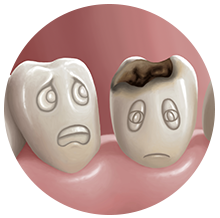Tooth Extractions
 Reasons for Pulling Teeth
Reasons for Pulling Teeth
Although permanent teeth were meant to last a lifetime, there are a number of reasons why tooth extraction may be needed. A very common reason involves a tooth that is too badly damaged, from trauma or decay, to be repaired. Other reasons include:
- A crowded mouth
Sometimes dentists pull teeth to prepare the mouth for orthodontia. The goal of orthodontia is to properly align the teeth, which may not be possible if your teeth are too big for your mouth. Likewise, if a tooth cannot break through the gum (erupt) because there is not room in the mouth for it, your dentist may recommend pulling it. - Infection
If tooth decay or damage extends to the pulp — the center of the tooth containing nerves and blood vessels — bacteria in the mouth can enter the pulp, leading to infection. Often this can be corrected with root canal therapy (RCT), but if the infection is so severe that antibiotics or RCT do not cure it, extraction may be needed to prevent the spread of infection. - Risk of infection
If your immune system is compromised (for example, if you are receiving chemotherapy or are having an organ transplant), even the risk of infection in a particular tooth may be reason enough to pull the tooth. - Periodontal (Gum) Disease
If periodontal disease — an infection of the tissues and bones that surround and support the teeth — have caused loosening of the teeth, it may be necessary to the pull the tooth or teeth.
When an extraction is necessary
When a tooth is severely decayed and cannot be saved, extracting it can be the best choice for relieving pain and preventing the spread of infection.
 Most decayed teeth can be saved
Most decayed teeth can be saved
Most decayed teeth can be treated successfully with a filling or crown. But for these treatments to work, there must be enough healthy tooth structure above the jawbone to support the restoration.
For example, a crown is often used to cover, protect, and restore a tooth that’s been damaged by decay. The crown attaches to the part of the tooth that’s above the bone, so an adequate amount of tooth structure must remain to hold the crown securely.
Some teeth cannot be saved
If too much of your tooth has been severely damaged by decay, there isn’t enough healthy tooth structure left to hold a restoration. In this case, we may have no choice but to remove what remains of the tooth.
Diagnosis and treatment
To determine if an extraction is right for your situation, we’ll perform a thorough exam, which typically includes x-rays.
If the tooth cannot be saved, it’s important to extract it as soon as possible to prevent infection in the tooth and jawbone. With modern dental techniques, the procedure should be a comfortable one for you. In many cases, we also recommend replacing an extracted tooth to preserve the jawbone and stabilize your bite, so we’ll talk with you about your replacement options.

